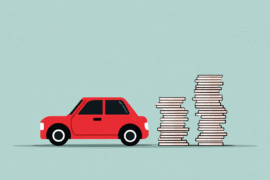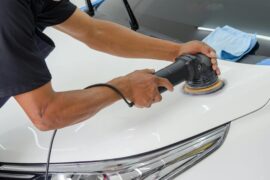This article may contain references to products or services from one or more of our advertisers or partners. We may receive compensation when you click on links to those products or services. Nonetheless, our opinions are our own.
The information presented in this article is accurate to the best of our knowledge at the time of publication. However, information is subject to change, and no guarantees are made about the continued accuracy or completeness of this content after its publication date.
Buying a used car can be both exciting and scary, especially if you’re looking at one with more than 100,000 miles on the odometer. You could be feeling both hopeful and unsure. You want to be sure that the thing you buy will last and be reliable, so you’re not just spending your hard-earned money. We’ll give you all the information you need to make an informed decision, from learning about the special things to think about when buying these kinds of cars to looking into your financing options. So, get ready to learn all about how to pay for a used car that could become a reliable friend on your future trips.
- The Risks and Rewards of High-Mileage Cars
- Assessing Your Budget for a Used Car with 100K Miles
- Navigating Financing Options for Older Vehicles
- How to Evaluate the Condition and Reliability of a High-Mileage Car
- Tips for Negotiating the Best Price on Your Used Car
- Preparing for Future Maintenance Costs: What You Need to Know
- Conclusion
- Frequently Asked Questions
- Is it advisable to finance a used car with over 100,000 miles?
- What should I consider before financing a high-mileage used car?
- Where can I find financing options for a used car with high mileage?
- Will the mileage affect my financing terms?
- What types of warranties or protections should I consider?
- Can financing a high-mileage car affect my credit score?
- What are some common pitfalls to avoid?
- Recommended Reads
The Risks and Rewards of High-Mileage Cars
It’s important to think about the pros and cons of a high-mileage car before you buy it. On the one hand, cars with more than 100,000 miles on them are usually cheaper, which means you can get more for your money. You might find some models that are still in good shape and have a lot of life left in them, especially if the previous owner took good care of them.
Some of the rewards include
- Greater Affordability: High-mileage cars generally cost less than their lower-mileage counterparts.
- Insurance Savings: Since older vehicles often have lower market values, you could save on insurance premiums.
- Depreciation Benefits: With the bulk of depreciation already taken, your investment may hold its value better over time.
However, there are risks that could turn your bargain into a burden:
- Potential Repairs: Older cars may require more frequent maintenance or repairs, leading to unforeseen expenses.
- Limited Warranty: Many high-mileage cars are long past their factory warranties, meaning you’ll need to budget for all repairs.
- Technology Obsolescence: Features in older vehicles might be outdated, lacking modern conveniences and safety technology.
To put things into perspective, here’s a quick look at how common repair costs can compare:
| Common Repairs | Estimated Cost |
|---|---|
| Brake Pad Replacement | $150-$300 |
| Timing Belt Replacement | $500-$1,000 |
| Transmission Fluid Change | $150-$300 |
| Alternator Replacement | $300-$600 |
Your choice should hinge on a thorough evaluation of the vehicle’s history, along with your readiness to handle ongoing maintenance. While a high-mileage car may offer great value, understanding the associated risks allows you to make a more informed decision.
Assessing Your Budget for a Used Car with 100K Miles
When evaluating your budget for purchasing a used car with 100,000 miles, it’s important to consider not only the purchase price but also the ongoing costs that come with it. Create a detailed breakdown of your finances to understand how much you can comfortably afford. Start by listing your current income and expenses to identify areas where you can tighten your budget.
Expenses to think about:
- Monthly Payments: Calculate what loan amount you can handle based on your down payment and monthly budget.
- Insurance: Get quotes for car insurance, as rates can vary substantially for older cars.
- Maintenance and Repairs: Older vehicles may require more upkeep; consider setting aside a monthly fund for these expenses.
Once you have a clearer picture of your budget, it might be wise to set limits on certain parameters. For example:
| Item | Estimated Cost | Description |
|---|---|---|
| Purchase Price | $8,000 | Cost of the used car |
| Insurance | $100/month | Average insurance cost |
| Maintenance | $50/month | Budget for potential repairs |
| Fuel | $150/month | Estimated fuel expenses |
By being thorough and realistic about your budget, you can ensure a smoother process when financing a used car. Remember, it’s not just about the sticker price—every dollar counts toward the total cost of ownership.
When considering financing options for a used vehicle with over 100,000 miles, it’s essential to do your research. Many traditional lenders may hesitate to extend credit for older cars due to concerns about reliability and resale value. However, several avenues cater to your unique situation:
- Credit Unions: These often offer competitive rates and may be more willing to finance older vehicles compared to larger banks.
- Specialized Lenders: Some companies specialize in financing high-mileage used cars and may provide more flexible terms.
- Personal Loans: If you have strong credit, a personal loan could be a viable option, as it isn’t tied directly to the vehicle’s age.
- Dealer Financing: While caution is advised, dealerships may offer financing packages for older vehicles, sometimes paired with warranties.
Compare interest rates and terms across options to ensure you’re getting the best possible deal. Here’s a quick breakdown:
| Financing Option | Pros | Cons |
|---|---|---|
| Credit Unions | Lower rates, member-focused | Membership required |
| Specialized Lenders | Higher acceptance, tailored offers | Possibly higher interest rates |
| Personal Loans | Flexible use of funds | High rates if credit is poor |
| Dealer Financing | Convenience, potential warranties | Often high interest rates |
Always keep your long-term financial goals in mind. A reliable used vehicle can be an asset, but understanding the full cost of ownership will help you manage your finances responsibly.
Voted "Best Overall Budgeting App" by Forbes and WSJ
Monarch Money helps you budget, track spending, set goals, and plan your financial future—all in one app.
Get 50% OFF your first year with code MONARCHVIP
How to Evaluate the Condition and Reliability of a High-Mileage Car
A thorough evaluation is the key to making sure you’re making a good investment when you’re thinking about a high-mileage car. The first thing you should do is look over the car’s maintenance history. A well-kept service record is a good sign of how the car has been cared for over the years. Check for proof that the oil has been changed regularly, the tires have been rotated, and any major repairs have been made, especially those to the engine or transmission. Check for rust, worn tires, or fluid leaks with your eyes. Next, drive the car and listen for any strange noises or vibrations. Lastly, have a professional check done by a mechanic you trust. They can find problems that aren’t obvious and give you a clear picture of how the car is doing, which can help you avoid expensive surprises later on.
Tips for Negotiating the Best Price on Your Used Car
It’s important to be ready when you try to haggle over the price of a used car, especially one with more than 100,000 miles on it. To begin, find out how much the car is worth on the market. You can use Kelley Blue Book and Edmunds to find a fair price.
Negotiation tips:
- Highlight the Car’s Condition: Use visible wear or missing features as leverage.
- Be Willing to Walk Away: Other options might yield better deals.
- Ask for Maintenance Records: A documented history can justify or lower the price.
- Consider Timing: Shopping at the end of the month or year may provide leverage.
Bringing data with you shows you’re informed and serious, giving you the upper hand in negotiations.
Preparing for Future Maintenance Costs: What You Need to Know
If you want to buy a used car with more than 100,000 miles on it, you should plan ahead for possible repair costs. Cars with more miles on them often need more repairs, and if you’re not ready, it can be stressful on your wallet.
Preparation tips:
- Research Common Repairs: Every model has known issues—learn what to expect.
- Estimate Annual Maintenance Costs: Budget $500–$1,000 per year for upkeep.
- Consider Extended Warranties: These can help protect against major expenses.
| Expense Type | Estimated Cost |
|---|---|
| Oil Changes | $50-$100 every 5,000 miles |
| Tires | $400-$800 every 30,000 miles |
| Brake Replacement | $300-$700 every 30,000 miles |
| Transmission Service | $80-$200 every 30,000 miles |
Proactive maintenance planning ensures your used vehicle remains reliable and your budget stays intact.
Conclusion
Many first-time buyers, especially those who want to save money up front, should consider financing a used car with more than 100,000 miles on it. But you need to plan, budget, and do your homework before making this choice. You can make a smart, confident purchase if you know the pros and cons, check the condition of the car, and look into all of your financing options. A high-mileage car can give you reliable value for years to come if you take care of it and know how much money you can spend.
Frequently Asked Questions
Is it advisable to finance a used car with over 100,000 miles?
Yes, especially if the vehicle has been well-maintained and has a solid history. Just be aware of the increased potential for repairs and factor this into your decision.
What should I consider before financing a high-mileage used car?
Review the vehicle’s maintenance history, get a professional inspection, and understand your financing costs. Always consider the car’s condition, lifespan, and your overall budget.
Where can I find financing options for a used car with high mileage?
Explore credit unions, banks, online lenders, and dealership financing. Always compare rates and terms to find the most favorable deal.
Will the mileage affect my financing terms?
Yes. Higher mileage may lead to higher interest rates or shorter loan terms due to perceived risk by lenders.
What types of warranties or protections should I consider?
An extended warranty or protection plan can help manage unexpected repairs. Also, check whether any manufacturer warranty still applies.
Can financing a high-mileage car affect my credit score?
Yes. Timely payments can improve your credit, while missed payments can damage it. Make sure the loan fits within your monthly budget.
What are some common pitfalls to avoid?
Avoid skipping inspections, underestimating repair costs, and signing financing agreements without fully understanding the terms. Be wary of deals that seem too good to be true.

Reviewed and edited by Albert Fang.
See a typo or want to suggest an edit/revision to the content? Use the contact us form to provide feedback.
At FangWallet, we value editorial integrity and open collaboration in curating quality content for readers to enjoy. Much appreciated for the assist.
Did you like our article and find it insightful? We encourage sharing the article link with family and friends to benefit as well - better yet, sharing on social media. Thank you for the support! 🍉
Article Title: Financing a Used Car With Over 100K Miles
https://fangwallet.com/2025/06/07/financing-a-used-car/The FangWallet Promise
FangWallet is an editorially independent resource - founded on breaking down challenging financial concepts for anyone to understand since 2014. While we adhere to editorial integrity, note that this post may contain references to products from our partners.
The FangWallet promise is always to have your best interest in mind and be transparent and honest about the financial picture.
Become an Insider

Subscribe to get a free daily budget planner printable to help get your money on track!
Make passive money the right way. No spam.
Editorial Disclaimer: The editorial content on this page is not provided by any of the companies mentioned. The opinions expressed here are the author's alone.
The content of this website is for informational purposes only and does not represent investment advice, or an offer or solicitation to buy or sell any security, investment, or product. Investors are encouraged to do their own due diligence, and, if necessary, consult professional advising before making any investment decisions. Investing involves a high degree of risk, and financial losses may occur including the potential loss of principal.
Source Citation References:
+ Inspo
There are no additional citations or references to note for this article at this time.












































